Mrs. Gina Bacc’s Case
VerifiedAdded on 2022/12/14
|9
|2625
|419
AI Summary
This essay provides a care plan using the seven steps of the Clinical Reasoning Cycle (CRC) based on Mrs. Gina’s case to analyze and discuss the underlying pathophysiology, identify nursing priorities of care, and outline appropriate nursing management.
Contribute Materials
Your contribution can guide someone’s learning journey. Share your
documents today.
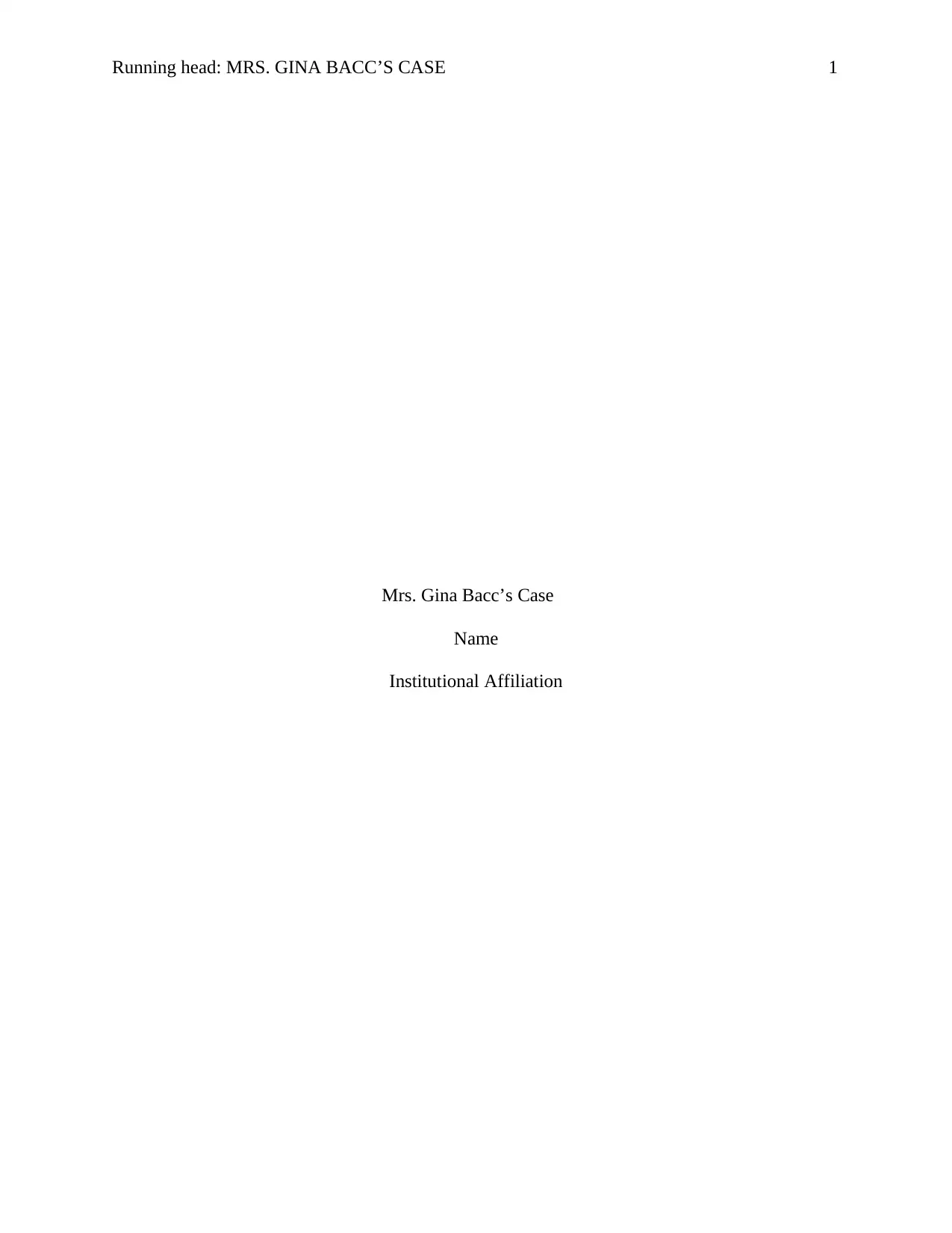
Running head: MRS. GINA BACC’S CASE 1
Mrs. Gina Bacc’s Case
Name
Institutional Affiliation
Mrs. Gina Bacc’s Case
Name
Institutional Affiliation
Secure Best Marks with AI Grader
Need help grading? Try our AI Grader for instant feedback on your assignments.
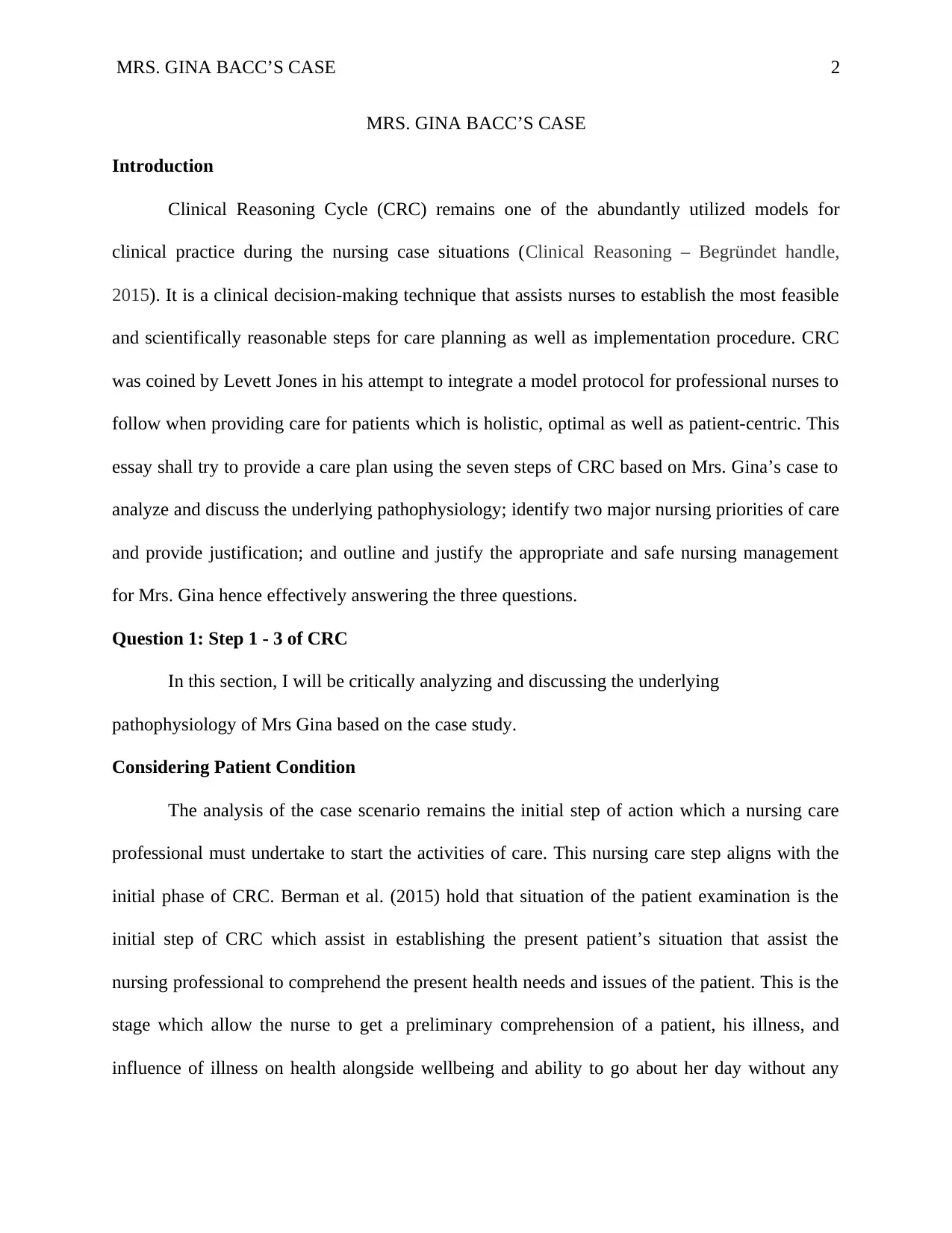
MRS. GINA BACC’S CASE 2
MRS. GINA BACC’S CASE
Introduction
Clinical Reasoning Cycle (CRC) remains one of the abundantly utilized models for
clinical practice during the nursing case situations (Clinical Reasoning – Begründet handle,
2015). It is a clinical decision-making technique that assists nurses to establish the most feasible
and scientifically reasonable steps for care planning as well as implementation procedure. CRC
was coined by Levett Jones in his attempt to integrate a model protocol for professional nurses to
follow when providing care for patients which is holistic, optimal as well as patient-centric. This
essay shall try to provide a care plan using the seven steps of CRC based on Mrs. Gina’s case to
analyze and discuss the underlying pathophysiology; identify two major nursing priorities of care
and provide justification; and outline and justify the appropriate and safe nursing management
for Mrs. Gina hence effectively answering the three questions.
Question 1: Step 1 - 3 of CRC
In this section, I will be critically analyzing and discussing the underlying
pathophysiology of Mrs Gina based on the case study.
Considering Patient Condition
The analysis of the case scenario remains the initial step of action which a nursing care
professional must undertake to start the activities of care. This nursing care step aligns with the
initial phase of CRC. Berman et al. (2015) hold that situation of the patient examination is the
initial step of CRC which assist in establishing the present patient’s situation that assist the
nursing professional to comprehend the present health needs and issues of the patient. This is the
stage which allow the nurse to get a preliminary comprehension of a patient, his illness, and
influence of illness on health alongside wellbeing and ability to go about her day without any
MRS. GINA BACC’S CASE
Introduction
Clinical Reasoning Cycle (CRC) remains one of the abundantly utilized models for
clinical practice during the nursing case situations (Clinical Reasoning – Begründet handle,
2015). It is a clinical decision-making technique that assists nurses to establish the most feasible
and scientifically reasonable steps for care planning as well as implementation procedure. CRC
was coined by Levett Jones in his attempt to integrate a model protocol for professional nurses to
follow when providing care for patients which is holistic, optimal as well as patient-centric. This
essay shall try to provide a care plan using the seven steps of CRC based on Mrs. Gina’s case to
analyze and discuss the underlying pathophysiology; identify two major nursing priorities of care
and provide justification; and outline and justify the appropriate and safe nursing management
for Mrs. Gina hence effectively answering the three questions.
Question 1: Step 1 - 3 of CRC
In this section, I will be critically analyzing and discussing the underlying
pathophysiology of Mrs Gina based on the case study.
Considering Patient Condition
The analysis of the case scenario remains the initial step of action which a nursing care
professional must undertake to start the activities of care. This nursing care step aligns with the
initial phase of CRC. Berman et al. (2015) hold that situation of the patient examination is the
initial step of CRC which assist in establishing the present patient’s situation that assist the
nursing professional to comprehend the present health needs and issues of the patient. This is the
stage which allow the nurse to get a preliminary comprehension of a patient, his illness, and
influence of illness on health alongside wellbeing and ability to go about her day without any
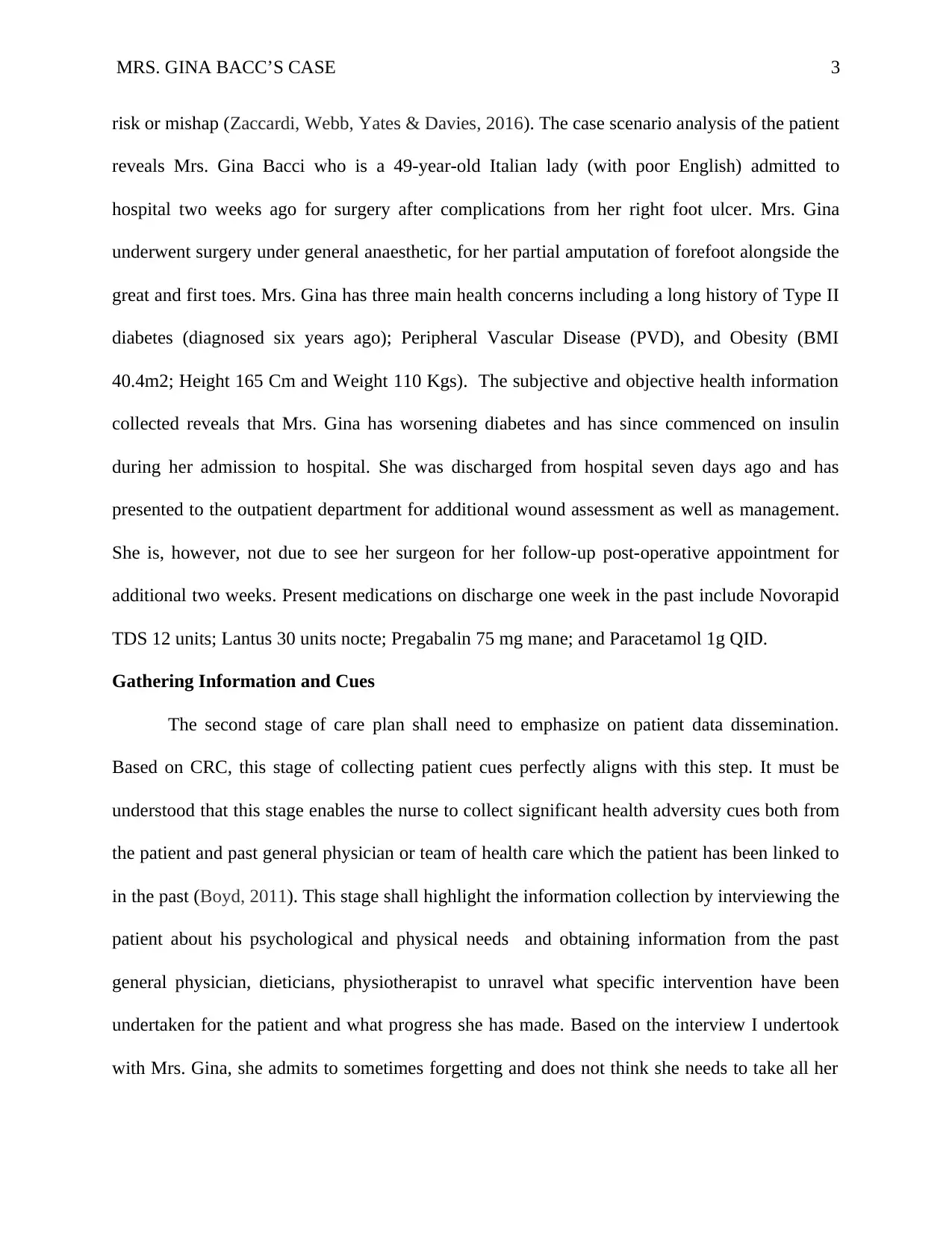
MRS. GINA BACC’S CASE 3
risk or mishap (Zaccardi, Webb, Yates & Davies, 2016). The case scenario analysis of the patient
reveals Mrs. Gina Bacci who is a 49-year-old Italian lady (with poor English) admitted to
hospital two weeks ago for surgery after complications from her right foot ulcer. Mrs. Gina
underwent surgery under general anaesthetic, for her partial amputation of forefoot alongside the
great and first toes. Mrs. Gina has three main health concerns including a long history of Type II
diabetes (diagnosed six years ago); Peripheral Vascular Disease (PVD), and Obesity (BMI
40.4m2; Height 165 Cm and Weight 110 Kgs). The subjective and objective health information
collected reveals that Mrs. Gina has worsening diabetes and has since commenced on insulin
during her admission to hospital. She was discharged from hospital seven days ago and has
presented to the outpatient department for additional wound assessment as well as management.
She is, however, not due to see her surgeon for her follow-up post-operative appointment for
additional two weeks. Present medications on discharge one week in the past include Novorapid
TDS 12 units; Lantus 30 units nocte; Pregabalin 75 mg mane; and Paracetamol 1g QID.
Gathering Information and Cues
The second stage of care plan shall need to emphasize on patient data dissemination.
Based on CRC, this stage of collecting patient cues perfectly aligns with this step. It must be
understood that this stage enables the nurse to collect significant health adversity cues both from
the patient and past general physician or team of health care which the patient has been linked to
in the past (Boyd, 2011). This stage shall highlight the information collection by interviewing the
patient about his psychological and physical needs and obtaining information from the past
general physician, dieticians, physiotherapist to unravel what specific intervention have been
undertaken for the patient and what progress she has made. Based on the interview I undertook
with Mrs. Gina, she admits to sometimes forgetting and does not think she needs to take all her
risk or mishap (Zaccardi, Webb, Yates & Davies, 2016). The case scenario analysis of the patient
reveals Mrs. Gina Bacci who is a 49-year-old Italian lady (with poor English) admitted to
hospital two weeks ago for surgery after complications from her right foot ulcer. Mrs. Gina
underwent surgery under general anaesthetic, for her partial amputation of forefoot alongside the
great and first toes. Mrs. Gina has three main health concerns including a long history of Type II
diabetes (diagnosed six years ago); Peripheral Vascular Disease (PVD), and Obesity (BMI
40.4m2; Height 165 Cm and Weight 110 Kgs). The subjective and objective health information
collected reveals that Mrs. Gina has worsening diabetes and has since commenced on insulin
during her admission to hospital. She was discharged from hospital seven days ago and has
presented to the outpatient department for additional wound assessment as well as management.
She is, however, not due to see her surgeon for her follow-up post-operative appointment for
additional two weeks. Present medications on discharge one week in the past include Novorapid
TDS 12 units; Lantus 30 units nocte; Pregabalin 75 mg mane; and Paracetamol 1g QID.
Gathering Information and Cues
The second stage of care plan shall need to emphasize on patient data dissemination.
Based on CRC, this stage of collecting patient cues perfectly aligns with this step. It must be
understood that this stage enables the nurse to collect significant health adversity cues both from
the patient and past general physician or team of health care which the patient has been linked to
in the past (Boyd, 2011). This stage shall highlight the information collection by interviewing the
patient about his psychological and physical needs and obtaining information from the past
general physician, dieticians, physiotherapist to unravel what specific intervention have been
undertaken for the patient and what progress she has made. Based on the interview I undertook
with Mrs. Gina, she admits to sometimes forgetting and does not think she needs to take all her
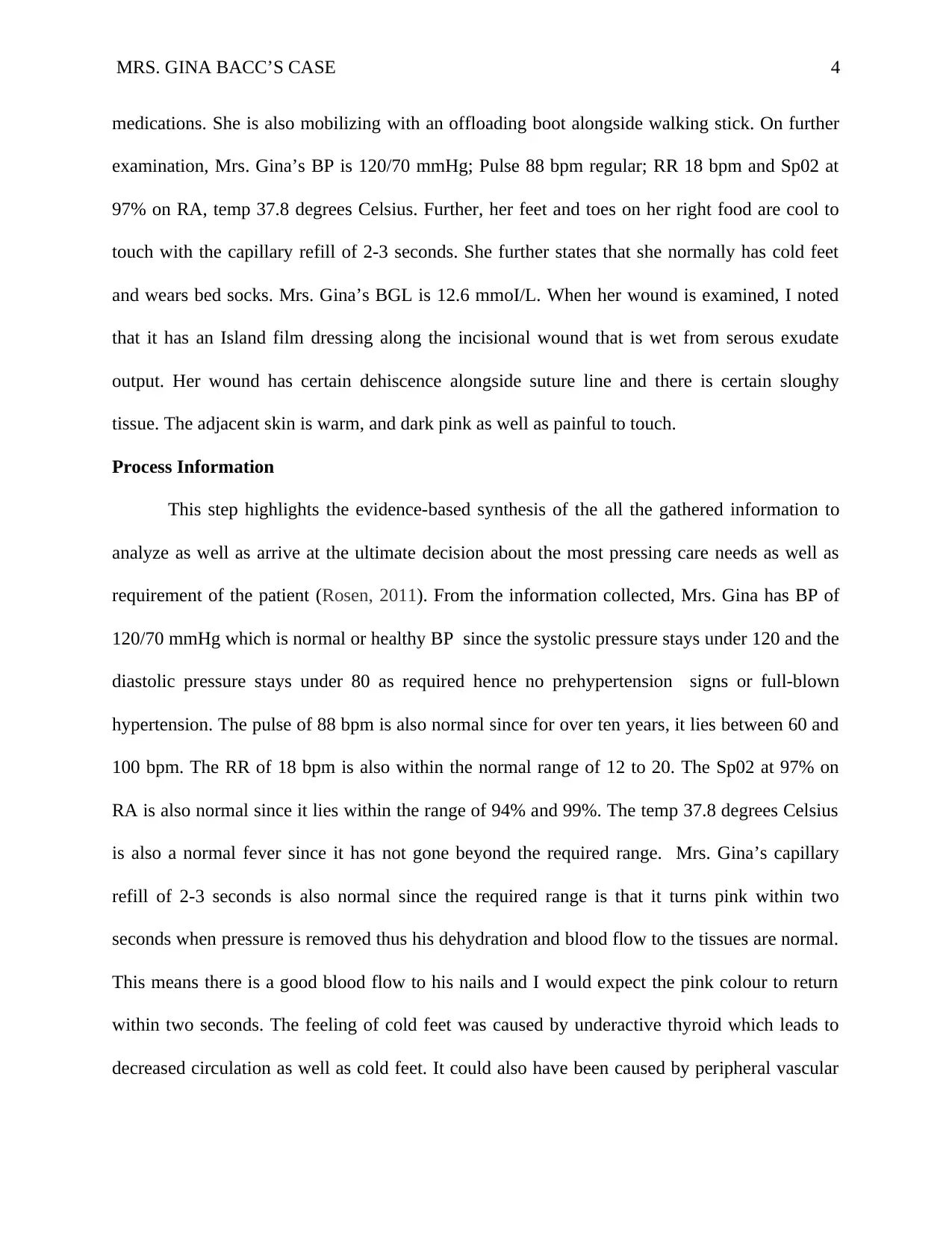
MRS. GINA BACC’S CASE 4
medications. She is also mobilizing with an offloading boot alongside walking stick. On further
examination, Mrs. Gina’s BP is 120/70 mmHg; Pulse 88 bpm regular; RR 18 bpm and Sp02 at
97% on RA, temp 37.8 degrees Celsius. Further, her feet and toes on her right food are cool to
touch with the capillary refill of 2-3 seconds. She further states that she normally has cold feet
and wears bed socks. Mrs. Gina’s BGL is 12.6 mmoI/L. When her wound is examined, I noted
that it has an Island film dressing along the incisional wound that is wet from serous exudate
output. Her wound has certain dehiscence alongside suture line and there is certain sloughy
tissue. The adjacent skin is warm, and dark pink as well as painful to touch.
Process Information
This step highlights the evidence-based synthesis of the all the gathered information to
analyze as well as arrive at the ultimate decision about the most pressing care needs as well as
requirement of the patient (Rosen, 2011). From the information collected, Mrs. Gina has BP of
120/70 mmHg which is normal or healthy BP since the systolic pressure stays under 120 and the
diastolic pressure stays under 80 as required hence no prehypertension signs or full-blown
hypertension. The pulse of 88 bpm is also normal since for over ten years, it lies between 60 and
100 bpm. The RR of 18 bpm is also within the normal range of 12 to 20. The Sp02 at 97% on
RA is also normal since it lies within the range of 94% and 99%. The temp 37.8 degrees Celsius
is also a normal fever since it has not gone beyond the required range. Mrs. Gina’s capillary
refill of 2-3 seconds is also normal since the required range is that it turns pink within two
seconds when pressure is removed thus his dehydration and blood flow to the tissues are normal.
This means there is a good blood flow to his nails and I would expect the pink colour to return
within two seconds. The feeling of cold feet was caused by underactive thyroid which leads to
decreased circulation as well as cold feet. It could also have been caused by peripheral vascular
medications. She is also mobilizing with an offloading boot alongside walking stick. On further
examination, Mrs. Gina’s BP is 120/70 mmHg; Pulse 88 bpm regular; RR 18 bpm and Sp02 at
97% on RA, temp 37.8 degrees Celsius. Further, her feet and toes on her right food are cool to
touch with the capillary refill of 2-3 seconds. She further states that she normally has cold feet
and wears bed socks. Mrs. Gina’s BGL is 12.6 mmoI/L. When her wound is examined, I noted
that it has an Island film dressing along the incisional wound that is wet from serous exudate
output. Her wound has certain dehiscence alongside suture line and there is certain sloughy
tissue. The adjacent skin is warm, and dark pink as well as painful to touch.
Process Information
This step highlights the evidence-based synthesis of the all the gathered information to
analyze as well as arrive at the ultimate decision about the most pressing care needs as well as
requirement of the patient (Rosen, 2011). From the information collected, Mrs. Gina has BP of
120/70 mmHg which is normal or healthy BP since the systolic pressure stays under 120 and the
diastolic pressure stays under 80 as required hence no prehypertension signs or full-blown
hypertension. The pulse of 88 bpm is also normal since for over ten years, it lies between 60 and
100 bpm. The RR of 18 bpm is also within the normal range of 12 to 20. The Sp02 at 97% on
RA is also normal since it lies within the range of 94% and 99%. The temp 37.8 degrees Celsius
is also a normal fever since it has not gone beyond the required range. Mrs. Gina’s capillary
refill of 2-3 seconds is also normal since the required range is that it turns pink within two
seconds when pressure is removed thus his dehydration and blood flow to the tissues are normal.
This means there is a good blood flow to his nails and I would expect the pink colour to return
within two seconds. The feeling of cold feet was caused by underactive thyroid which leads to
decreased circulation as well as cold feet. It could also have been caused by peripheral vascular
Secure Best Marks with AI Grader
Need help grading? Try our AI Grader for instant feedback on your assignments.
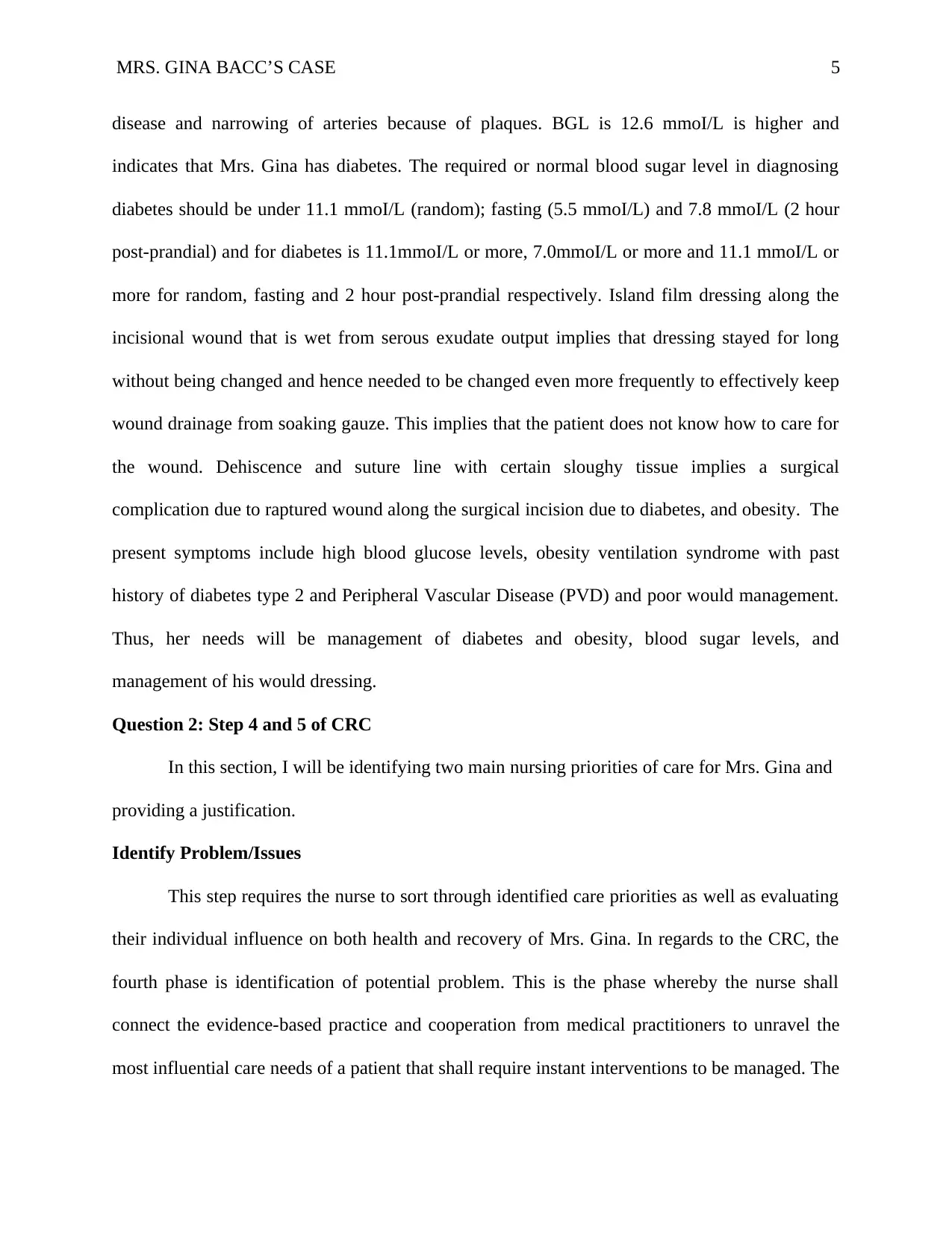
MRS. GINA BACC’S CASE 5
disease and narrowing of arteries because of plaques. BGL is 12.6 mmoI/L is higher and
indicates that Mrs. Gina has diabetes. The required or normal blood sugar level in diagnosing
diabetes should be under 11.1 mmoI/L (random); fasting (5.5 mmoI/L) and 7.8 mmoI/L (2 hour
post-prandial) and for diabetes is 11.1mmoI/L or more, 7.0mmoI/L or more and 11.1 mmoI/L or
more for random, fasting and 2 hour post-prandial respectively. Island film dressing along the
incisional wound that is wet from serous exudate output implies that dressing stayed for long
without being changed and hence needed to be changed even more frequently to effectively keep
wound drainage from soaking gauze. This implies that the patient does not know how to care for
the wound. Dehiscence and suture line with certain sloughy tissue implies a surgical
complication due to raptured wound along the surgical incision due to diabetes, and obesity. The
present symptoms include high blood glucose levels, obesity ventilation syndrome with past
history of diabetes type 2 and Peripheral Vascular Disease (PVD) and poor would management.
Thus, her needs will be management of diabetes and obesity, blood sugar levels, and
management of his would dressing.
Question 2: Step 4 and 5 of CRC
In this section, I will be identifying two main nursing priorities of care for Mrs. Gina and
providing a justification.
Identify Problem/Issues
This step requires the nurse to sort through identified care priorities as well as evaluating
their individual influence on both health and recovery of Mrs. Gina. In regards to the CRC, the
fourth phase is identification of potential problem. This is the phase whereby the nurse shall
connect the evidence-based practice and cooperation from medical practitioners to unravel the
most influential care needs of a patient that shall require instant interventions to be managed. The
disease and narrowing of arteries because of plaques. BGL is 12.6 mmoI/L is higher and
indicates that Mrs. Gina has diabetes. The required or normal blood sugar level in diagnosing
diabetes should be under 11.1 mmoI/L (random); fasting (5.5 mmoI/L) and 7.8 mmoI/L (2 hour
post-prandial) and for diabetes is 11.1mmoI/L or more, 7.0mmoI/L or more and 11.1 mmoI/L or
more for random, fasting and 2 hour post-prandial respectively. Island film dressing along the
incisional wound that is wet from serous exudate output implies that dressing stayed for long
without being changed and hence needed to be changed even more frequently to effectively keep
wound drainage from soaking gauze. This implies that the patient does not know how to care for
the wound. Dehiscence and suture line with certain sloughy tissue implies a surgical
complication due to raptured wound along the surgical incision due to diabetes, and obesity. The
present symptoms include high blood glucose levels, obesity ventilation syndrome with past
history of diabetes type 2 and Peripheral Vascular Disease (PVD) and poor would management.
Thus, her needs will be management of diabetes and obesity, blood sugar levels, and
management of his would dressing.
Question 2: Step 4 and 5 of CRC
In this section, I will be identifying two main nursing priorities of care for Mrs. Gina and
providing a justification.
Identify Problem/Issues
This step requires the nurse to sort through identified care priorities as well as evaluating
their individual influence on both health and recovery of Mrs. Gina. In regards to the CRC, the
fourth phase is identification of potential problem. This is the phase whereby the nurse shall
connect the evidence-based practice and cooperation from medical practitioners to unravel the
most influential care needs of a patient that shall require instant interventions to be managed. The
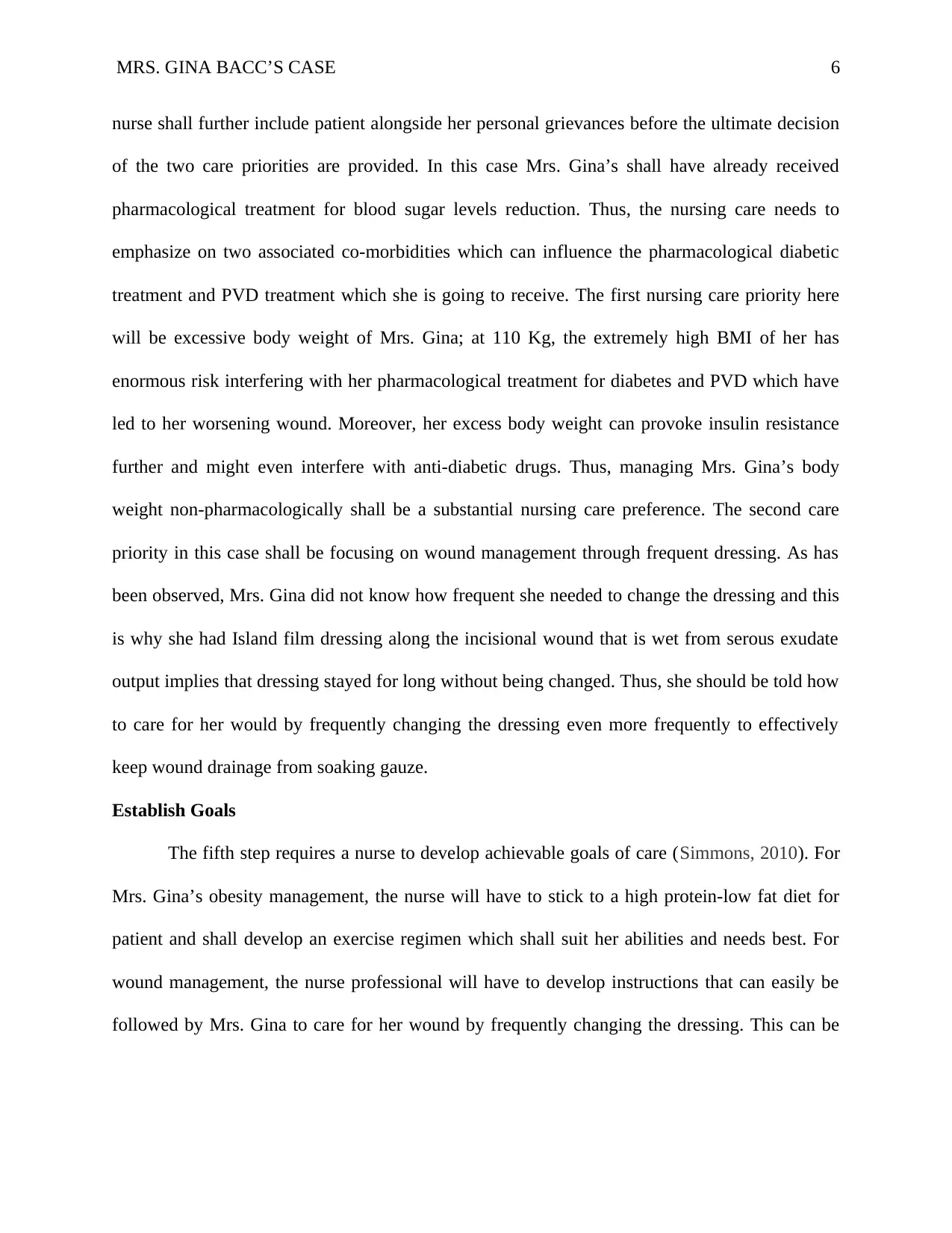
MRS. GINA BACC’S CASE 6
nurse shall further include patient alongside her personal grievances before the ultimate decision
of the two care priorities are provided. In this case Mrs. Gina’s shall have already received
pharmacological treatment for blood sugar levels reduction. Thus, the nursing care needs to
emphasize on two associated co-morbidities which can influence the pharmacological diabetic
treatment and PVD treatment which she is going to receive. The first nursing care priority here
will be excessive body weight of Mrs. Gina; at 110 Kg, the extremely high BMI of her has
enormous risk interfering with her pharmacological treatment for diabetes and PVD which have
led to her worsening wound. Moreover, her excess body weight can provoke insulin resistance
further and might even interfere with anti-diabetic drugs. Thus, managing Mrs. Gina’s body
weight non-pharmacologically shall be a substantial nursing care preference. The second care
priority in this case shall be focusing on wound management through frequent dressing. As has
been observed, Mrs. Gina did not know how frequent she needed to change the dressing and this
is why she had Island film dressing along the incisional wound that is wet from serous exudate
output implies that dressing stayed for long without being changed. Thus, she should be told how
to care for her would by frequently changing the dressing even more frequently to effectively
keep wound drainage from soaking gauze.
Establish Goals
The fifth step requires a nurse to develop achievable goals of care (Simmons, 2010). For
Mrs. Gina’s obesity management, the nurse will have to stick to a high protein-low fat diet for
patient and shall develop an exercise regimen which shall suit her abilities and needs best. For
wound management, the nurse professional will have to develop instructions that can easily be
followed by Mrs. Gina to care for her wound by frequently changing the dressing. This can be
nurse shall further include patient alongside her personal grievances before the ultimate decision
of the two care priorities are provided. In this case Mrs. Gina’s shall have already received
pharmacological treatment for blood sugar levels reduction. Thus, the nursing care needs to
emphasize on two associated co-morbidities which can influence the pharmacological diabetic
treatment and PVD treatment which she is going to receive. The first nursing care priority here
will be excessive body weight of Mrs. Gina; at 110 Kg, the extremely high BMI of her has
enormous risk interfering with her pharmacological treatment for diabetes and PVD which have
led to her worsening wound. Moreover, her excess body weight can provoke insulin resistance
further and might even interfere with anti-diabetic drugs. Thus, managing Mrs. Gina’s body
weight non-pharmacologically shall be a substantial nursing care preference. The second care
priority in this case shall be focusing on wound management through frequent dressing. As has
been observed, Mrs. Gina did not know how frequent she needed to change the dressing and this
is why she had Island film dressing along the incisional wound that is wet from serous exudate
output implies that dressing stayed for long without being changed. Thus, she should be told how
to care for her would by frequently changing the dressing even more frequently to effectively
keep wound drainage from soaking gauze.
Establish Goals
The fifth step requires a nurse to develop achievable goals of care (Simmons, 2010). For
Mrs. Gina’s obesity management, the nurse will have to stick to a high protein-low fat diet for
patient and shall develop an exercise regimen which shall suit her abilities and needs best. For
wound management, the nurse professional will have to develop instructions that can easily be
followed by Mrs. Gina to care for her wound by frequently changing the dressing. This can be
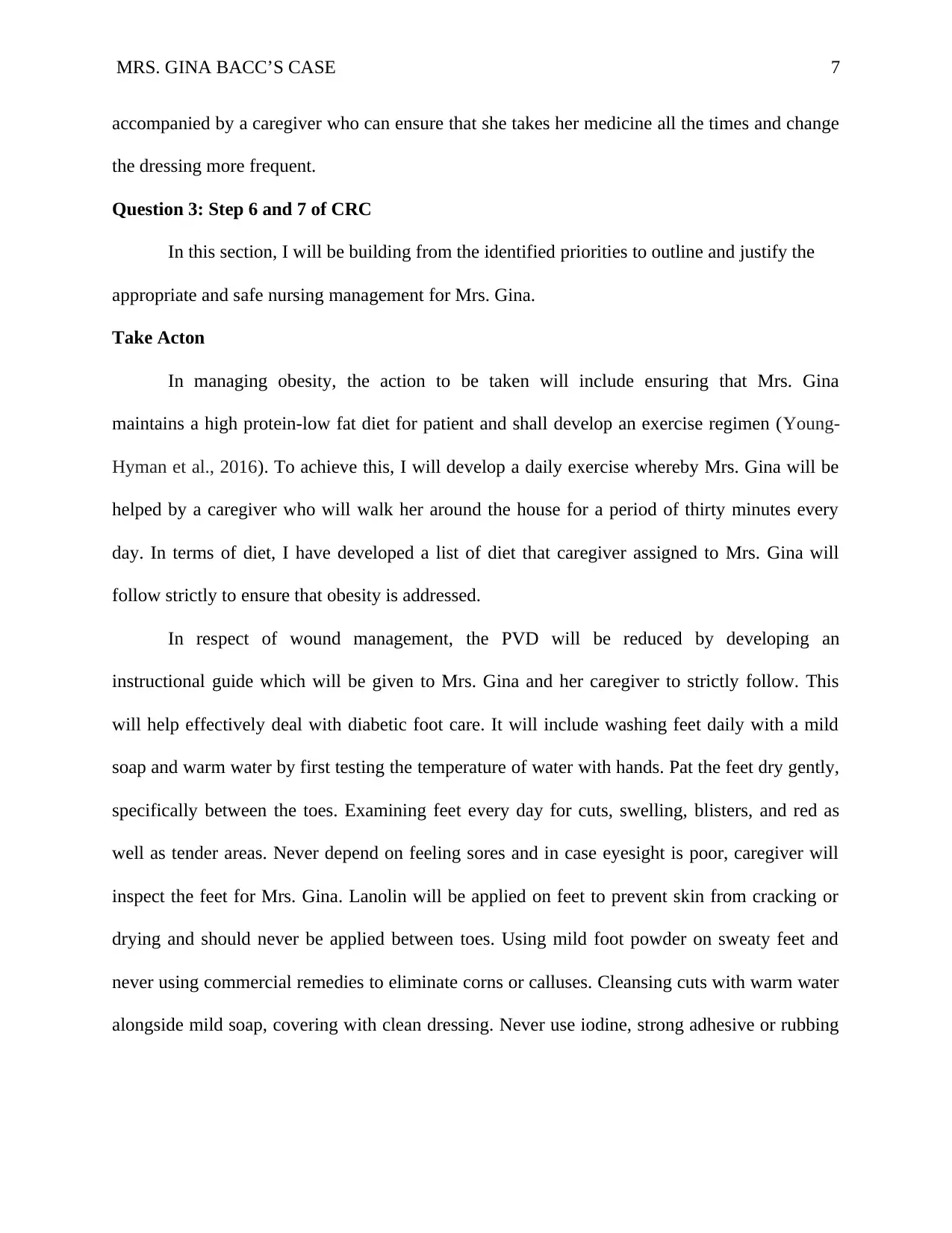
MRS. GINA BACC’S CASE 7
accompanied by a caregiver who can ensure that she takes her medicine all the times and change
the dressing more frequent.
Question 3: Step 6 and 7 of CRC
In this section, I will be building from the identified priorities to outline and justify the
appropriate and safe nursing management for Mrs. Gina.
Take Acton
In managing obesity, the action to be taken will include ensuring that Mrs. Gina
maintains a high protein-low fat diet for patient and shall develop an exercise regimen (Young-
Hyman et al., 2016). To achieve this, I will develop a daily exercise whereby Mrs. Gina will be
helped by a caregiver who will walk her around the house for a period of thirty minutes every
day. In terms of diet, I have developed a list of diet that caregiver assigned to Mrs. Gina will
follow strictly to ensure that obesity is addressed.
In respect of wound management, the PVD will be reduced by developing an
instructional guide which will be given to Mrs. Gina and her caregiver to strictly follow. This
will help effectively deal with diabetic foot care. It will include washing feet daily with a mild
soap and warm water by first testing the temperature of water with hands. Pat the feet dry gently,
specifically between the toes. Examining feet every day for cuts, swelling, blisters, and red as
well as tender areas. Never depend on feeling sores and in case eyesight is poor, caregiver will
inspect the feet for Mrs. Gina. Lanolin will be applied on feet to prevent skin from cracking or
drying and should never be applied between toes. Using mild foot powder on sweaty feet and
never using commercial remedies to eliminate corns or calluses. Cleansing cuts with warm water
alongside mild soap, covering with clean dressing. Never use iodine, strong adhesive or rubbing
accompanied by a caregiver who can ensure that she takes her medicine all the times and change
the dressing more frequent.
Question 3: Step 6 and 7 of CRC
In this section, I will be building from the identified priorities to outline and justify the
appropriate and safe nursing management for Mrs. Gina.
Take Acton
In managing obesity, the action to be taken will include ensuring that Mrs. Gina
maintains a high protein-low fat diet for patient and shall develop an exercise regimen (Young-
Hyman et al., 2016). To achieve this, I will develop a daily exercise whereby Mrs. Gina will be
helped by a caregiver who will walk her around the house for a period of thirty minutes every
day. In terms of diet, I have developed a list of diet that caregiver assigned to Mrs. Gina will
follow strictly to ensure that obesity is addressed.
In respect of wound management, the PVD will be reduced by developing an
instructional guide which will be given to Mrs. Gina and her caregiver to strictly follow. This
will help effectively deal with diabetic foot care. It will include washing feet daily with a mild
soap and warm water by first testing the temperature of water with hands. Pat the feet dry gently,
specifically between the toes. Examining feet every day for cuts, swelling, blisters, and red as
well as tender areas. Never depend on feeling sores and in case eyesight is poor, caregiver will
inspect the feet for Mrs. Gina. Lanolin will be applied on feet to prevent skin from cracking or
drying and should never be applied between toes. Using mild foot powder on sweaty feet and
never using commercial remedies to eliminate corns or calluses. Cleansing cuts with warm water
alongside mild soap, covering with clean dressing. Never use iodine, strong adhesive or rubbing
Paraphrase This Document
Need a fresh take? Get an instant paraphrase of this document with our AI Paraphraser

MRS. GINA BACC’S CASE 8
alcohol. Exercise feet daily via walking or flexing or extending feet in suspended stance and
avoiding prolonged standing, sitting or crossing of legs.
Evaluating Outcomes
The positon has significantly improved. Mrs. Gina’s BGL has greatly reduced. Also, Mrs.
Gina’s weight has decreased from 110 kg to 107 Kg. Further, Mrs. Gina can now understanding
how to care for her wound and change the dressing frequently. She is no longer feeling the cold
feet and the pain when the leg is touched has significantly reduced.
Conclusion
It is worth noting that CRC acts as the best model for nurses to utilize in their daily care
activities such that designing and implementing care procedure is patient-centric as feasible
(Pinnock & Welch, 2013). It helps both organize care planning in a few stepwise actions, and act
as a justification of care plan which is being implemented on an underlying patient. In this case,
CRC assisted design a full and effective care program emphasizing on two issues relevant to
Mrs. Gina’s case study.
alcohol. Exercise feet daily via walking or flexing or extending feet in suspended stance and
avoiding prolonged standing, sitting or crossing of legs.
Evaluating Outcomes
The positon has significantly improved. Mrs. Gina’s BGL has greatly reduced. Also, Mrs.
Gina’s weight has decreased from 110 kg to 107 Kg. Further, Mrs. Gina can now understanding
how to care for her wound and change the dressing frequently. She is no longer feeling the cold
feet and the pain when the leg is touched has significantly reduced.
Conclusion
It is worth noting that CRC acts as the best model for nurses to utilize in their daily care
activities such that designing and implementing care procedure is patient-centric as feasible
(Pinnock & Welch, 2013). It helps both organize care planning in a few stepwise actions, and act
as a justification of care plan which is being implemented on an underlying patient. In this case,
CRC assisted design a full and effective care program emphasizing on two issues relevant to
Mrs. Gina’s case study.
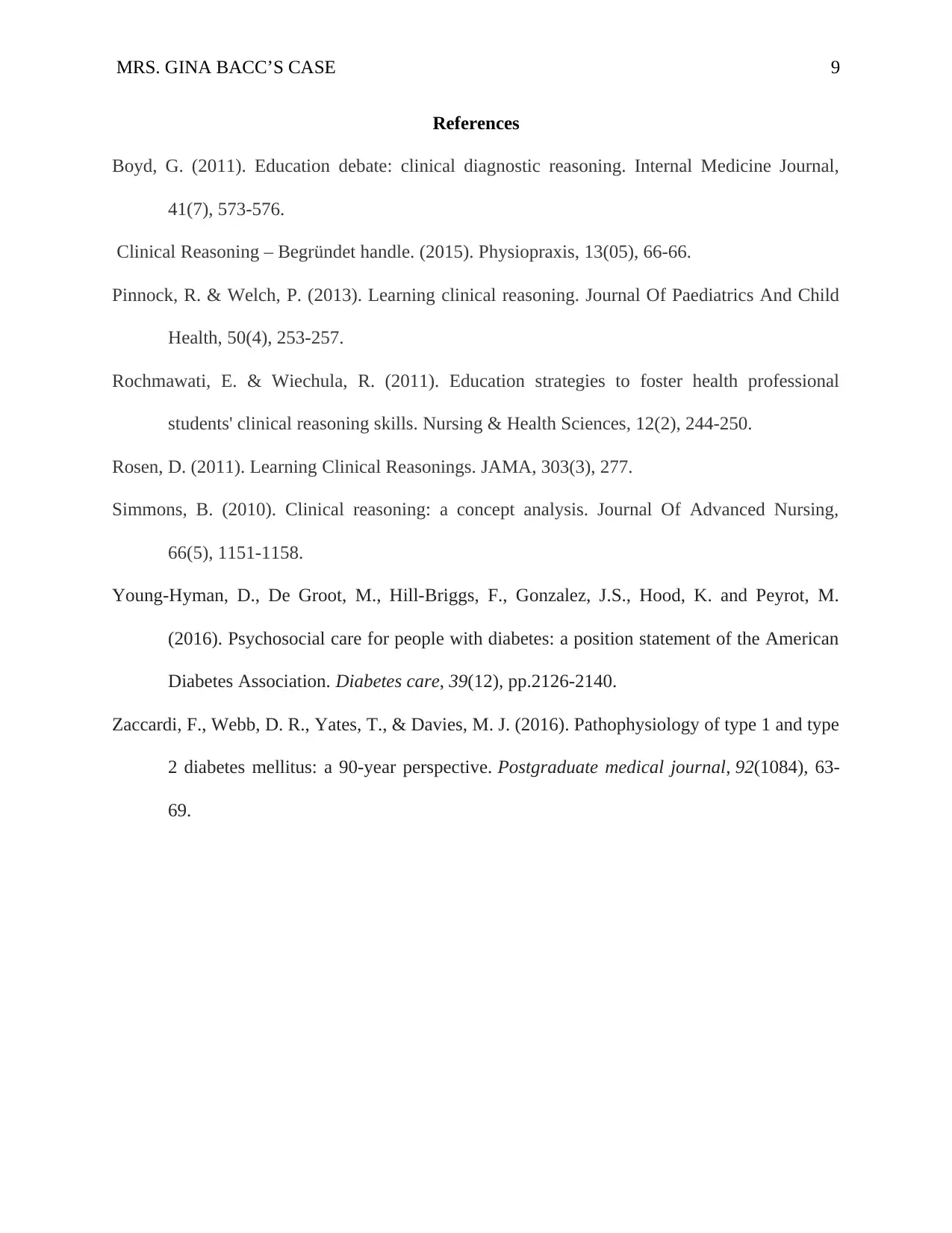
MRS. GINA BACC’S CASE 9
References
Boyd, G. (2011). Education debate: clinical diagnostic reasoning. Internal Medicine Journal,
41(7), 573-576.
Clinical Reasoning – Begründet handle. (2015). Physiopraxis, 13(05), 66-66.
Pinnock, R. & Welch, P. (2013). Learning clinical reasoning. Journal Of Paediatrics And Child
Health, 50(4), 253-257.
Rochmawati, E. & Wiechula, R. (2011). Education strategies to foster health professional
students' clinical reasoning skills. Nursing & Health Sciences, 12(2), 244-250.
Rosen, D. (2011). Learning Clinical Reasonings. JAMA, 303(3), 277.
Simmons, B. (2010). Clinical reasoning: a concept analysis. Journal Of Advanced Nursing,
66(5), 1151-1158.
Young-Hyman, D., De Groot, M., Hill-Briggs, F., Gonzalez, J.S., Hood, K. and Peyrot, M.
(2016). Psychosocial care for people with diabetes: a position statement of the American
Diabetes Association. Diabetes care, 39(12), pp.2126-2140.
Zaccardi, F., Webb, D. R., Yates, T., & Davies, M. J. (2016). Pathophysiology of type 1 and type
2 diabetes mellitus: a 90-year perspective. Postgraduate medical journal, 92(1084), 63-
69.
References
Boyd, G. (2011). Education debate: clinical diagnostic reasoning. Internal Medicine Journal,
41(7), 573-576.
Clinical Reasoning – Begründet handle. (2015). Physiopraxis, 13(05), 66-66.
Pinnock, R. & Welch, P. (2013). Learning clinical reasoning. Journal Of Paediatrics And Child
Health, 50(4), 253-257.
Rochmawati, E. & Wiechula, R. (2011). Education strategies to foster health professional
students' clinical reasoning skills. Nursing & Health Sciences, 12(2), 244-250.
Rosen, D. (2011). Learning Clinical Reasonings. JAMA, 303(3), 277.
Simmons, B. (2010). Clinical reasoning: a concept analysis. Journal Of Advanced Nursing,
66(5), 1151-1158.
Young-Hyman, D., De Groot, M., Hill-Briggs, F., Gonzalez, J.S., Hood, K. and Peyrot, M.
(2016). Psychosocial care for people with diabetes: a position statement of the American
Diabetes Association. Diabetes care, 39(12), pp.2126-2140.
Zaccardi, F., Webb, D. R., Yates, T., & Davies, M. J. (2016). Pathophysiology of type 1 and type
2 diabetes mellitus: a 90-year perspective. Postgraduate medical journal, 92(1084), 63-
69.
1 out of 9
Related Documents
Your All-in-One AI-Powered Toolkit for Academic Success.
+13062052269
info@desklib.com
Available 24*7 on WhatsApp / Email
![[object Object]](/_next/static/media/star-bottom.7253800d.svg)
Unlock your academic potential
© 2024 | Zucol Services PVT LTD | All rights reserved.





